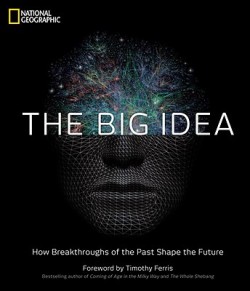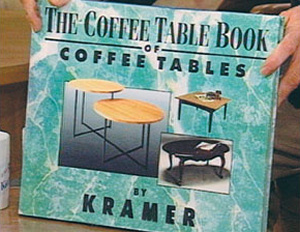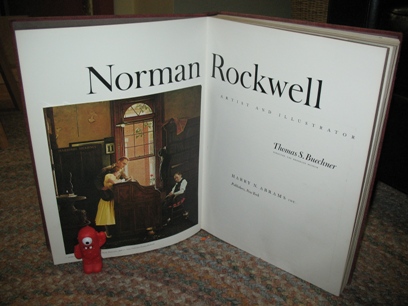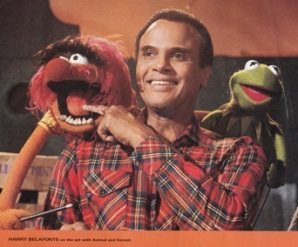Some of my favorite book reviews come from Boing Boing, a tech-focused culture blog that you’ve probably already heard of and that I’ll sound like an idiot if I try to explain any further. It’s a wonderful online hub for news and commentary, featuring contributors that write intelligently and passionately about a wide range of subjects. One of those subjects, from time to time, is books and, as I should’ve expected, their book reviews are as intelligent and passionate as the rest of the blog.
Last week, Maggie Koerth-Baker, penned a great review of a new National Geographic coffee table book called The Big Idea: How Breakthroughs of the Past Shape the Future, and there was a passage in her review about the impact that coffee table books can have on kids that I absolutely adore. She wrote:
I still think kids and coffee table books go together like peanut butter and jelly. In late grade school and junior high, you’re at an age where you still enjoy picture books but are looking for a bigger, deeper view of the world than most picture books provide. Coffee table books bridge that gap, offering grown-up perspectives in kid-friendly packages. Whether the topic is art, architecture, history, culture, or science—coffee table books can be a kid’s first step into a subject they’ll come to love as an adult.
I could NOT agree with Maggie more, and I totally heart her for describing something that I rant about every few months in way more eloquent terms than I ever could.
OK, this blog is all about giving advice about building a home library, right? So, here is one of my top five favorite pieces of advice to give parents who are trying to put together a collection of books for their children: Make sure that your kid – whether they’re 2 or 12 years old – has access to a big variety of coffee table books.
Why? Because, as Maggie stated, they’re fantastic windows into worlds that most kids just don’t have the ability to experience on their own. While picture books often present big, lush illustrated landscapes – sometimes based on real life, but normally fictionalized – coffee table books present a completely different experience. Coffee table books are all about curation. They’re about collecting perspectives on the real world, gathering together that material, showing the connections between that material, and then presenting those collections in the most visually appealing way possible. If those curated collections are attractive to adult audiences, can you imagine how powerful they’d be for a younger audience? I’m already aware that there are collections of Van Gogh paintings in the world. I’ve visited the castles of Ireland. But, for a six or ten-year-old whose experience with the outside world begins and ends with TV or maybe a trip to EPCOT, those coffee table books are like annotated guidebooks to the outside world.
Now, granted, as parents, you do need to make sure that the material is appropriate for your kid – no Mapplethorpe or Occult Art of the Third Reich, please – but, beyond vetting the subject matter, I wouldn’t worry too much about whether your child will actually be able to read the book. That’s not really the point. I think a big part of the appeal of coffee table books for kids is that you’re presenting your young ones with a package that was obviously NOT designed for them. They can tell it’s a book that was designed for adults and that makes it all the more appealing.
Coffee table books are aspirational books for those young readers. They know these are books for adults and they know that they have to work to uncover their meaning. Yes, at first, kids will be drawn in by the visual and design aspects of the book, but, as time goes on, you can watch them start to understand the organization of the book. They start understanding the structure of the collection, they start reading the text, and, with every new layer of meaning they uncover, the appeal of the book deepens. It’s a fun thing to watch.
Growing up, the coffee table book that I fell in love with was a massive two-inch-thick art tome called Norman Rockwell, Artist and Illustrator, edited by Thomas S. Buechner, the director of the Brooklyn Museum. It was a hand-me-down from my grandmother, and I spent hours and hours combing over Rockwell’s illustrations, awestruck at the variety of human faces on display. The book started out as a gigantic comic book, allowing me to laugh at the crazy one-panel comic strips that graced all those Saturday Evening Postcovers, but, as I got older, my appreciation for the book grew into something deeper. I started noticing the subtext in the relationships between Rockwell’s subjects. I started appreciating the skill behind his art. And, eventually, I started recognizing some of the more loaded social commentary that graced Rockwell’s later works and could clearly see Rockwell’s artistic evolution that led him there, all thanks to Buechner’s curation of the volume. It’s a book I still adore and will one day pass right back down to my daughter.
In her review, Maggie Koerth-Baker talks about the appeal of coffee table books for “late grade school and junior high” kids, but I think you can start even earlier. (Again, make sure the subject matter isn’t too extreme or pervy.) With my daughter (who just turned five today… choke, sob), we started with big, visual photography books and then moved her into subject areas that we knew she’d enjoy. Specifically, The Muppets.
Both my wife and I were hardcore Muppets fans as children and, as adults, we’d started amassing a pretty decent collection of books about The Muppets, Jim Henson, and Henson’s legacy. Once we realized that our daughter was becoming a Muppets fan too, I put some of our larger, more photography-heavy Muppet books in front of her and watched her light up immediately. She was two-years-old at the time and she adored them. She poured over them. She still pours over them. We would go on two-day car trips to Florida and she’d spent HOURS in her car seat, just endlessly flipping through these gigantic Muppet books that were almost as tall as she was.
The two books she loved more than anything were two works by Christopher Finch – the easy-to-find Jim Henson: The Works – The Art, the Magic, the Imagination and the now out-of-print Of Muppets and Men: The Making of the Muppet Show.
Now, you may be asking yourself, what can a two-year-old glean from a picture book about a television show from the 1970s? You’d be surprised.
That video alone should make you want to go out and buy some coffee table books for your kids. Now, don’t get me wrong, if you introduce coffee table books to a two-year-old, they WILL get destroyed. So, you might want to stick to the bargain racks at your local bookstore or, at the very least, make sure that you really don’t mind if the book gets torn to shreds. (We probably shouldn’t have let her cut loose on Of Muppets or Men – it can go for a fair bit on eBay – but the fact that my two-year-old could pick Peter Sellers out of a crowd, in my mind, made it totally worth it.)
And, now that my daughter is older, I’ve had a lot of fun with her at the library figuring out new coffee table books for her to explore. She loves coffee table books about movie production and covets a Making of the Nightmare Before Christmas book that we’ve checked out 12 times from our library. She enjoys flipping through the catalogs of exhibits at the Detroit Institute of Arts so much that I’ve actually debated buying her a $120 coffee table book of the full collection. And, now that she’s very into superheroes for the moment, she’s had great fun exploring Paul Dini and Chip Kidd’s fantastic Batman Animated, an amazing retrospective on Batman: The Animated Series, even though I think she’s still too young to actually watch the show yet.
All of this is just a long-winded way of saying, Maggie Koerth-Baker is definitely onto something. Coffee table books do offer “grown-up perspectives in kid-friendly packages”, and why wouldn’t you want to expose your children to something like that?




{ 0 comments… add one now }
You must log in to post a comment.